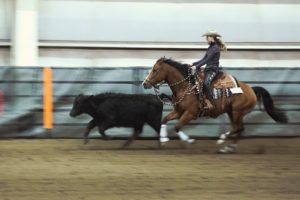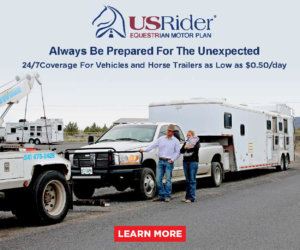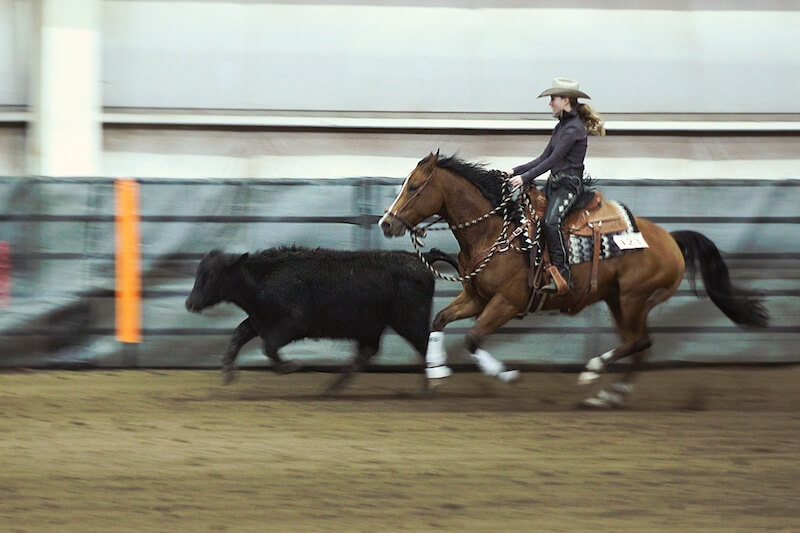Multiple Therapies Keep Hard-Working Horses Going Strong
By Theresa Rice
Performance horses are true athletes in their disciplines. Whether you’re training and maintaining that athlete yourself or paying a trainer to do it, you want to keep your horse in the best physical condition possible. All athletes benefit from working with personal trainers and physical therapists, receiving massage and chiropractic, and icing muscles––horse and human. Our performance horses deserve body care along with food, water, exercise and shelter.
Like humans, horses’ bodies develop physical ruts, stiffness, and one-sidedness. There are ways of preventing injury in the first place that have nothing to do with the training schedule. Take, for example, a turnout pasture with other horses. At a minimum you expect to see bite marks, but a well-placed kick can lame your horse and take them out of the training routine for weeks at a time––something you don’t want to gamble with in the middle of a busy show season.

Outside of avoiding injuries, there are a wealth of practices for treating muscle tightness, unevenness and also aid in muscle recovery. While the saying goes, “No hoof, no horse,” it may as well include the legs. A horse’s legs are vital to their movement. You can protect them during a workout by making sure footing is appropriate, using splint boots or polo wraps, and overreach boots (for horses that need them.)
After a training session, treat your equine athlete to similar treatment professional human athletes use: ice down fatigued muscles and legs. You can’t necessarily get out the horse-sized ice bath, but you can hose their legs and muscles to achieve a similar affect. Icing has been shown to decrease pain and inflammation. Hosing down can also help recovery time and speed up the body’s response to chemicals released during workouts that can cause muscle soreness later on.
Bring in a certified veterinary chiropractor to assess your horse, perform releases, and give you some exercises to do between sessions that will help keep your horse limber.
Over time, bodies can develop habits––the way a horse holds its head, a tightness in the withers, or an easier bend in one direction versus the other. These habits of movement can impact how a horse performs; this is often the reason people reference a horse’s “good side” the same way people are right-handed versus left-handed. You want your horse to be as even as possible on both sides and supple throughout their back.
A chiropractor can identify areas of stiffness and perform maneuvers to release that stiffness over time. While an animal massage therapist can also offer help in relaxing tight muscles, a veterinary chiropractor has gone to veterinary school and above that, a chiropractic program.
There are also more contemporary recovery treatments. Magna wave therapy (pulsed electro-magnetic field) uses electromagnetic pulses which can help reduce pain and swelling. Magna wave therapy has been used in people and horses.
There is also a product called Theraplate, which is a large vibrating platform horses can stand on. Vibration therapy has been used in humans for some time, including by NASA to increase the bone density of astronauts*. As a therapy tool it has proven to be as effective as massage for decreasing muscle soreness, recovery in range of motion, and decreasing the presence of post-exercise metabolites. Although we love our horses, a full body massage isn’t easy to accommodate, meaning that the Theraplate has a real value in helping horses recover after training sessions.
Muscle recovery can also be aided via dietary supplements. MSM (methylsulfonylmethane) has been shown to decrease muscle inflammation and soreness and reduce the presence of metabolites indicative of muscle damage. In one study of Standardbred racing horses, the horses treated with MSM also showed an improvement in their racing times*. The supplement is a great source of dietary sulfur which aids in the production of collagen, cartilage, hooves, hair, and joint fluid.
Whatever your training schedule and intensity of workouts, including recovery care for your equine athlete can help keep them in pique physical condition for as long as possible, prolonging their career and your partnership.

Theresa grew up riding horses off and on throughout her life, finally fulfilling her dream of horse ownership in 2012. She is currently working on her first novel, inspired by her time spent working on a guest ranch in Arizona where she met her husband. They married in 2012. When not writing, you can find her riding her half-Arabian gelding, Gangster, or chasing after her two German Shepherds. website: www.sassinboots.com






